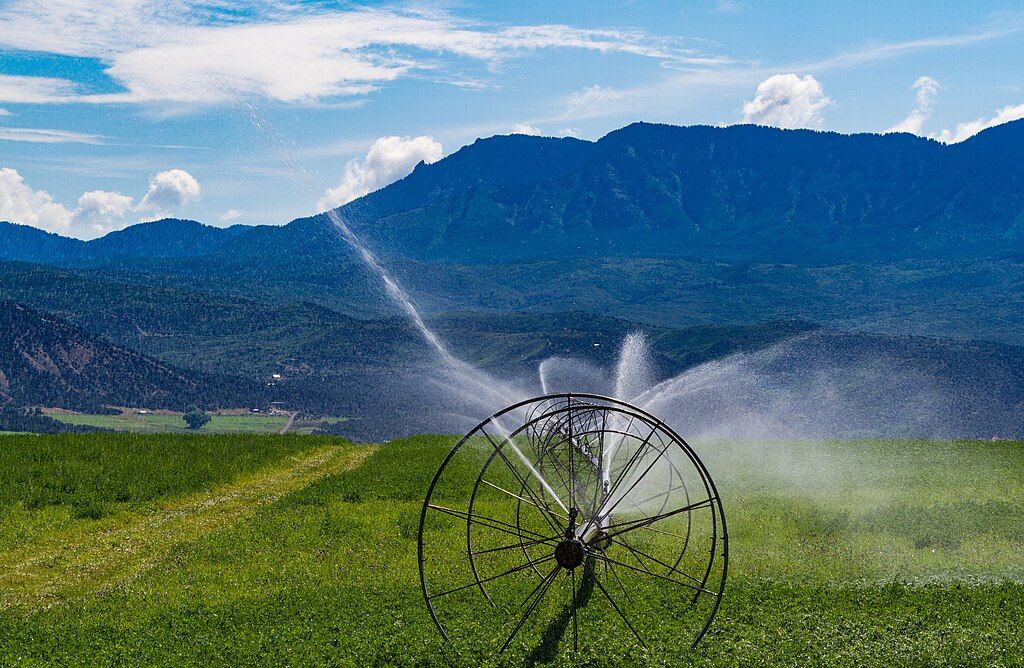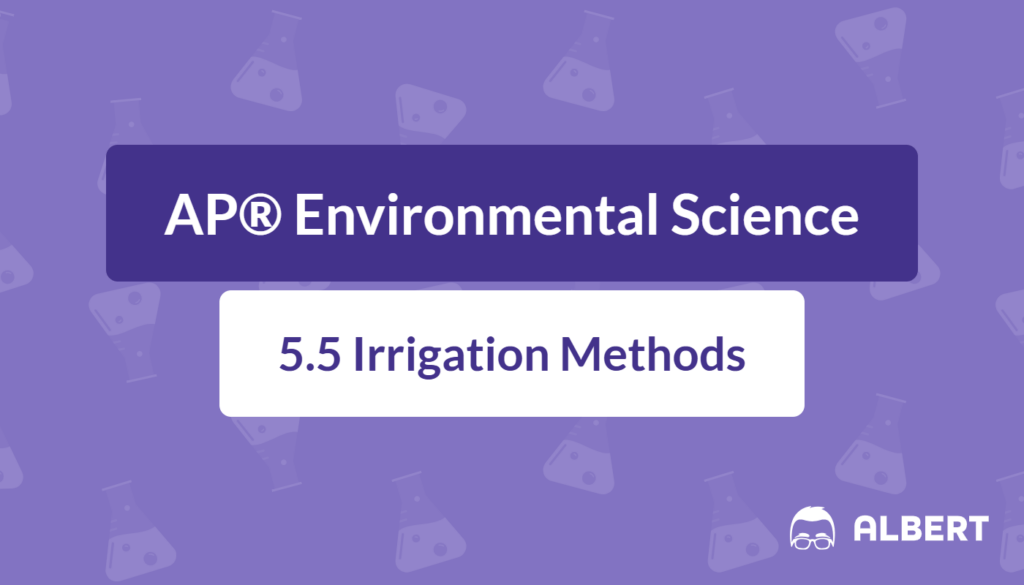What We Review
Introduction
Irrigation influences global food production by ensuring that crops have enough water to grow. In agriculture, approximately 70% of all freshwater usage supports various irrigation practices. Through effective irrigation, farmers can increase yields and reduce crop failures. However, different irrigation methods have varying effects on soil, water resources, and long-term sustainability.
This guide outlines four major irrigation techniques—flood, furrow, spray, and drip—and compares their advantages, drawbacks, and environmental impacts. It also introduces key concepts such as waterlogging, salinization, and aquifer depletion. Understanding these methods is essential for success on the AP® Environmental Science exam and for making responsible choices about water use in agriculture.
What Is Irrigation?
Irrigation is the controlled application of water to crops. Its main purpose is to supplement natural precipitation and maintain adequate soil moisture. Freshwater diverted for farming makes up the bulk of global water demand, so choosing efficient irrigation systems is particularly important. Whether it is delivered through canals, sprinklers, or drip lines, irrigation helps sustain food production in regions where rainfall might be unpredictable or insufficient.
Types of Irrigation Methods
Flood Irrigation
Flood irrigation involves releasing water directly onto the land until the field is partially covered. The water soaks into the soil and eventually drains away. This technique is especially common in areas with flat terrain.
Step-by-Step Example
- Water is diverted from a river or reservoir into a network of canals.
- The farmer opens gates to flood the fields.
- The water is left standing until the soil can absorb it.
- Excess water drains off or evaporates.
Benefits and Drawbacks
- Flood irrigation is relatively simple and can cost less to implement. However, about 20% of the water is lost through evaporation and runoff. In addition, overflooding can result in waterlogging, where water saturates the soil and restricts roots from receiving enough oxygen.
Furrow Irrigation
Furrow irrigation requires digging small, parallel channels—called furrows—between rows of crops. Water flows through these channels, irrigating the root zone.
Step-by-Step Example
- Shallow trenches are created in the soil between crop rows.
- Water is released into the furrows, moving slowly by gravity.
- As water seeps out from the channels, it soaks into the surrounding soil.
- Once the furrows are full, flow is stopped to prevent oversaturation.
Benefits and Drawbacks
- Furrow irrigation is inexpensive and easy to set up. However, around 33% of the water can be lost to evaporation and runoff. When water remains in furrows for too long, the soil can become oversaturated, which may cause root damage and nutrient leaching.
Spray Irrigation
Spray irrigation uses a system of pipes and sprinkler heads to shower fields with water. This setup often involves pumps that draw groundwater or surface water to the sprinklers.

Step-by-Step Example
- Water is pumped from a well, reservoir, or canal into pipes.
- Pressure forces the water out through sprinkler nozzles.
- The rotating or fixed sprinklers distribute water across the field.
- The flow can be easily controlled to match crop needs and weather conditions.
Benefits and Drawbacks
- Spray irrigation is more efficient than flood or furrow methods because it loses only about 25% or less of the water to evaporation and runoff. Nonetheless, it is more expensive to install and run, particularly due to pump energy costs. Additionally, if the sprinkler heads are not maintained, water can be unevenly dispersed, leading to dry patches or over-irrigated zones.
Drip Irrigation
Drip irrigation provides water through perforated pipes or hoses placed near the roots of each plant. Frequent, small applications of water help maintain optimal soil moisture.
Step-by-Step Example
- Pipes or hoses with tiny holes (emitters) are laid along rows of crops.
- Water drips from these emitters directly into the root zone.
- Flow rates are controlled to match plant demands.
- The system can be scheduled through timers to further customize watering.
Benefits and Drawbacks
- Drip irrigation is considered the most efficient method because it reduces evaporation and runoff to only about 5%. It also targets water precisely where plants need it. However, the initial setup is costly, making it less common in areas that lack funding or infrastructure. Small emitters can also become clogged if the water is not properly filtered.
Comparative Analysis of Irrigation Methods
Different irrigation approaches offer distinct trade-offs in efficiency, cost, and ease of use. Flood and furrow systems are relatively cheap but can waste significant amounts of water. Spray irrigation is more efficient yet costs more to build and operate. Meanwhile, drip irrigation excels at minimizing water loss but requires a substantial investment.
When choosing an irrigation method, farmers must balance their budgets with environmental considerations. Efficiency is important to conserve water and protect local water supplies. Nonetheless, more technologically advanced systems may involve higher expenses. Therefore, local climate, crop type, and soil conditions all play important roles in this decision.
Environmental Impacts of Irrigation Methods
Irrigation makes it possible to grow food in regions with limited rainfall. However, there can be adverse consequences for soil and water resources:
Waterlogging
- When irrigation delivers too much water, it can saturate the soil and raise the water table. Plants need oxygen around their roots to survive. Waterlogged soils can starve roots of oxygen, slowing plant growth and eventually causing them to die. Flood irrigation is especially prone to creating these conditions if not carefully managed.
Salinization
- Salinization occurs when water evaporates from irrigated soils, leaving behind salts. Over time, the accumulation of these salts can turn soil toxic to most crops. Furrow irrigation in hot, dry climates may exacerbate salinization because water constantly evaporates from the surface, concentrating salts.
Aquifer Depletion
- Irrigation often depends on groundwater reserves known as aquifers. These underground water stores can be depleted if extraction rates exceed recharge rates. The Ogallala Aquifer in the central United States is a well-known example. Intensive irrigation in that region has significantly lowered the water table, jeopardizing future water availability for both farming and local communities.
Conclusion
Irrigation underpins modern agriculture, yet each method involves different levels of efficiency, cost, and environmental risk. Flood irrigation is straightforward but can be wasteful. Furrow irrigation remains inexpensive but may lose a significant portion of water. Spray irrigation offers better control, while drip irrigation provides maximum efficiency. However, advanced systems often require higher financial investment.
Selecting a suitable irrigation method is essential for sustainable agriculture. Making informed choices can help conserve water and maintain healthy soils. Ultimately, balanced decisions benefit food production, natural resources, and local economies.
Key Vocabulary
- Irrigation: The controlled application of water to crops to supplement rainfall.
- Waterlogging: A condition where soil becomes overly saturated, restricting oxygen availability to roots.
- Salinization: Accumulation of salt in soil due to evaporation, which can harm plant growth.
- Furrow Irrigation: A method involving shallow channels between crop rows to deliver water.
- Drip Irrigation: A high-efficiency system that releases water directly to the plant root zone through small emitters.
- Aquifer: An underground layer of water-bearing rock or sediment used as a source of groundwater.
Sharpen Your Skills for AP® Environmental Science
Are you preparing for the AP® Environmental Science test? We’ve got you covered! Try our review articles designed to help you confidently tackle real-world AP® Environmental Science problems. You’ll find everything you need to succeed, from quick tips to detailed strategies. Start exploring now!
Need help preparing for your AP® Environmental Science exam?
Albert has hundreds of AP® Environmental Science practice questions, free response, and full-length practice tests to try out.








